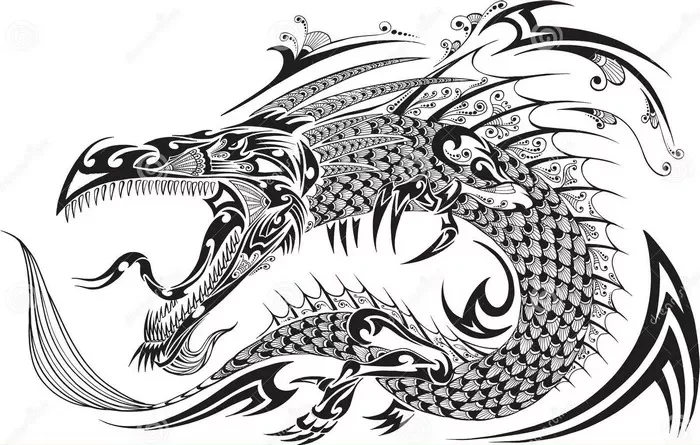Origins and Cultural Context:
The art of tattooing has a rich and storied history in both Chinese and Japanese cultures, with dragon tattoos holding a particularly prominent place in the iconography of both traditions. These mythical creatures, while sharing certain similarities, carry distinct symbolism and visual characteristics that differentiate Chinese dragon tattoos from their Japanese counterparts.
Both Chinese and Japanese dragon tattoos trace their origins to ancient mythologies deeply ingrained in their respective cultures. In Chinese mythology, dragons are revered creatures symbolizing power, luck, and balance. They are often associated with the emperor, representing imperial authority and divine protection. In contrast, Japanese dragons have a different connotation, rooted in Shinto and Buddhist beliefs. They are viewed as guardians and protectors, embodying traits such as wisdom, strength, and courage.
Visual Characteristics:
Chinese Dragon Tattoos:
Chinese dragon tattoos are characterized by their majestic and powerful appearance. Traditionally depicted with five claws, these dragons symbolize the emperor’s supreme authority. They are often portrayed as serpentine creatures with elongated bodies, adorned with colorful scales and sharp claws. Chinese dragon tattoos may also feature the mythical creature spitting fire or engulfed in flames, emphasizing their association with strength and vitality. Additionally, these tattoos frequently incorporate symbols of the Yin and Yang, representing the harmonious balance of opposing forces in the universe.
Japanese Dragon Tattoos:
In contrast to their Chinese counterparts, Japanese dragon tattoos typically portray these mythical creatures as slender, wingless serpents. One notable difference is the number of claws, with Japanese dragons having three toes instead of five. This distinction reflects the influence of Japanese folklore, where dragons are often associated with sea serpents due to Japan’s island geography. Japanese dragon tattoos emphasize elegance and fluidity, with intricate designs that highlight the creature’s sinuous movements. These tattoos may also incorporate elements of water, such as waves or clouds, further emphasizing their connection to the ocean.
Symbolism and Meaning:
Chinese Dragons:
Chinese dragon tattoos hold deep symbolism, representing fear, power, and strength. As symbols of imperial authority, they embody the virtues of leadership and protection. Additionally, Chinese dragons are believed to possess the ability to control the elements, making them potent symbols of transformation and renewal. They are also associated with the number nine, which is considered auspicious in Chinese culture, further enhancing their significance as symbols of good fortune and prosperity.
Japanese Dragons:
In Japanese culture, dragons are revered as guardians and protectors. Japanese dragon tattoos symbolize qualities such as wisdom, courage, and adaptability. Unlike their Chinese counterparts, which are often depicted as symbols of authority, Japanese dragons are viewed as benevolent beings that offer guidance and support to those in need. They are also associated with the concept of overcoming challenges, reflecting the belief that adversity can lead to personal growth and enlightenment.
Legends and Stories:
Chinese:
One of the most famous legends involving Chinese dragons is the story of the Dragon Kings. According to myth, there are four Dragon Kings who rule over the seas, each commanding their own domain. These powerful creatures are believed to control the tides and weather, making offerings to them during times of drought or famine. In Chinese folklore, dragons are also associated with the creation of the universe, symbolizing the cyclical nature of existence.
Japanese:
In Japanese mythology, dragons play a central role in the origin story of the imperial family. According to legend, the first emperor of Japan, Emperor Jimmu, was said to be descended from the sun goddess Amaterasu and the dragon king’s daughter, Toyotama-hime. This mythical union symbolizes the divine lineage of the imperial family and their connection to the spiritual realm. Japanese dragons are also featured prominently in folktales and legends, where they are often depicted as protectors of villages and warriors against evil spirits.
Conclusion:
While Chinese and Japanese dragon tattoos share common themes of power, mythology, and symbolism, they also exhibit distinct characteristics that reflect the unique cultural traditions of each society. Chinese dragon tattoos are renowned for their majestic appearance and association with imperial authority, whereas Japanese dragon tattoos emphasize elegance and spiritual significance. By exploring the origins, visual characteristics, symbolism, and legends associated with these mythical creatures, tattoo enthusiasts can gain a deeper understanding of the cultural heritage behind these iconic designs. Whether as symbols of strength and protection or as expressions of personal identity, Chinese and Japanese dragon tattoos continue to captivate and inspire individuals around the world.

